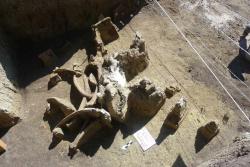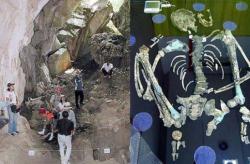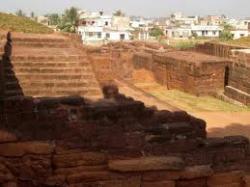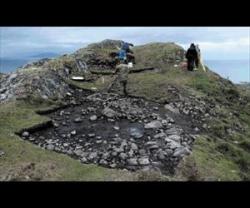INSTITUT SUPERIEUR D'ANTHROPOLOGIE
INSTITUTE OF ANTHROPOLOGY
ONLINE COURSES / COURS A DISTANCE
INSCRIPTION : Année Universitaire 2012/2013
REGISTRATION : Academic Year 2012 / 2013
MEXIQUE –  Atontonilco de Tula - More than a hundred bones of animals, some of which could possibly be human bones from the final stages of the Pleistocene period, more than 10,000 years ago, were found in Atontonilco de Tula, Hidalgo, during the construction work of a blackwater treatment plant, where archaeologists of the National Institute of Archaeology and History (INAH – Conaculta) made the rescue. The types of osseous remains of the extinct animals –some of which measure up to 1.60 meters (5.3 feet)– can be categorized in ribs, vertebras, craniums, jawbones, fangs, horns and shells, of species such as the glyptodont, mastodon, mammoth, camel, equine, deer, possible bison and others yet unidentifiable. In the ensemble of bones of the megafauna, two stone tools of the same epoch were discovered; they had remained buried for various millenniums near the site where the drain channel of Mexico City leads to. The salvage of these remains required meticulous archaeological excavation labors that lasted five months. This is the most numerous and varied finding of extinct megafauna remains, found together, registered up to date in Cuenca de Mexico, emphasized archaeologist Alicia Bonfil Olivera, as she released the news of the discovery that would help obtain vast information about the variety of animal species that lived in this part of the country about 10,000 or 12,000 years ago; tentatively dating from the last Pleistocene period, in the duration of which occurred the last glaciations of the Ice Age. The finding of such quantity of animals of that epoch happened during the excavations, which in occasions reached up to 20 meters (65.7 feet) deep, to create a blackwater treatment plant, near El Salto river. The archaeological work was done by the joint labor of INAH through the Direction of Archaeological Salvage, the National Water Commission and the Valle de Mexico Water Treatment Company. Scattered at distinct distances within an approximate extension of 100 acres, and between 7 and 10 meters (22.1 and 32.9 feet) deep, the team directed by the INAH specialist found more than 100 osseous remains, among which there seems to be some human bones which are mixed up with the extinct animal remains, “the characteristics and size of some bones indicate they were human limbs, which is not strange since we know that humans already habituated in the central region of Mexico in that time, however, a physical anthropologist will have to confirm this fact”.
Atontonilco de Tula - More than a hundred bones of animals, some of which could possibly be human bones from the final stages of the Pleistocene period, more than 10,000 years ago, were found in Atontonilco de Tula, Hidalgo, during the construction work of a blackwater treatment plant, where archaeologists of the National Institute of Archaeology and History (INAH – Conaculta) made the rescue. The types of osseous remains of the extinct animals –some of which measure up to 1.60 meters (5.3 feet)– can be categorized in ribs, vertebras, craniums, jawbones, fangs, horns and shells, of species such as the glyptodont, mastodon, mammoth, camel, equine, deer, possible bison and others yet unidentifiable. In the ensemble of bones of the megafauna, two stone tools of the same epoch were discovered; they had remained buried for various millenniums near the site where the drain channel of Mexico City leads to. The salvage of these remains required meticulous archaeological excavation labors that lasted five months. This is the most numerous and varied finding of extinct megafauna remains, found together, registered up to date in Cuenca de Mexico, emphasized archaeologist Alicia Bonfil Olivera, as she released the news of the discovery that would help obtain vast information about the variety of animal species that lived in this part of the country about 10,000 or 12,000 years ago; tentatively dating from the last Pleistocene period, in the duration of which occurred the last glaciations of the Ice Age. The finding of such quantity of animals of that epoch happened during the excavations, which in occasions reached up to 20 meters (65.7 feet) deep, to create a blackwater treatment plant, near El Salto river. The archaeological work was done by the joint labor of INAH through the Direction of Archaeological Salvage, the National Water Commission and the Valle de Mexico Water Treatment Company. Scattered at distinct distances within an approximate extension of 100 acres, and between 7 and 10 meters (22.1 and 32.9 feet) deep, the team directed by the INAH specialist found more than 100 osseous remains, among which there seems to be some human bones which are mixed up with the extinct animal remains, “the characteristics and size of some bones indicate they were human limbs, which is not strange since we know that humans already habituated in the central region of Mexico in that time, however, a physical anthropologist will have to confirm this fact”.
http://www.artdaily.org/index.asp?int_sec=2&int_new=57503#.UEYjc43N9wo
MALAISIE –  Lenggong Valley - On June 30, the United Nations Educational, Scientific and Cultural Organisation (Unesco) declared Lenggong Valley in Hulu Perak as a world heritage site. The declaration was made following the discovery of artifacts, which were more than 1.8 million years old, through excavation works by the country’s archaeologists. The beauty of this site is that ancient remains from the Palaeolithic, Neolithic and Metal ages are all found here. The complete remains of the Perak Man was the earliest human skeletal remains to be found in this region, believed to be about 11,000 years old. It was discovered in 1991. Lenggong is one of the places that contain much historical information. There are many myths and legends involving the caves in Lenggong. One of the famous caves is the Gua Gunung Runtuh which was the final resting place for the Perak Man. Gua Gunung Runtuh is situated in Bukit Kepala Gajah in the Lenggong Valley of Ulu Perak. The Perak Man skeleton found in Gua Gunung Runtuh is that of a male with a height of 157cm and aged about 50. He was buried in the fetal position, ie with legs tucked towards the chest, his right arm touching his shoulder and his left arm bent so that his hand would rest on his stomach. Besides that, they found deposits of animal bones at his right shoulder, to his left and to his rear, and deposits of stone tools around the body. Gua Puteri is a natural tunnel which pierces Bukit Kajang. There are no archaeological finds here, but the cave is known for its legends. Two stalagmites are believed to be a prince and princess who guard the cave. Locals say that if children climb up the stalagmites they will fall sick. Negrito cave drawings have been found at various sites but are not prehistoric, as they are only about 100 years old. Gua Badak is one of the main places for these drawings and is about 10km north of Lenggong. The Negritos are one of the aboriginal tribes of Malaysia. The Lanoh Negrito made the illustrative recordings of their every life. If one travels from Ipoh to Royal Belum, we will pass by Lenggong. Belum Valley, which covers 300,000ha of pristine rainforest, is known as Belum Temenggor Forest Complex and consists of several forest reserves. The main area is the Royal Belum (North) and Temenggor Forest Reserve (South). This rainforest is estimated to be more than 130 million years old and considered as one of the world’s oldest rainforests.
Lenggong Valley - On June 30, the United Nations Educational, Scientific and Cultural Organisation (Unesco) declared Lenggong Valley in Hulu Perak as a world heritage site. The declaration was made following the discovery of artifacts, which were more than 1.8 million years old, through excavation works by the country’s archaeologists. The beauty of this site is that ancient remains from the Palaeolithic, Neolithic and Metal ages are all found here. The complete remains of the Perak Man was the earliest human skeletal remains to be found in this region, believed to be about 11,000 years old. It was discovered in 1991. Lenggong is one of the places that contain much historical information. There are many myths and legends involving the caves in Lenggong. One of the famous caves is the Gua Gunung Runtuh which was the final resting place for the Perak Man. Gua Gunung Runtuh is situated in Bukit Kepala Gajah in the Lenggong Valley of Ulu Perak. The Perak Man skeleton found in Gua Gunung Runtuh is that of a male with a height of 157cm and aged about 50. He was buried in the fetal position, ie with legs tucked towards the chest, his right arm touching his shoulder and his left arm bent so that his hand would rest on his stomach. Besides that, they found deposits of animal bones at his right shoulder, to his left and to his rear, and deposits of stone tools around the body. Gua Puteri is a natural tunnel which pierces Bukit Kajang. There are no archaeological finds here, but the cave is known for its legends. Two stalagmites are believed to be a prince and princess who guard the cave. Locals say that if children climb up the stalagmites they will fall sick. Negrito cave drawings have been found at various sites but are not prehistoric, as they are only about 100 years old. Gua Badak is one of the main places for these drawings and is about 10km north of Lenggong. The Negritos are one of the aboriginal tribes of Malaysia. The Lanoh Negrito made the illustrative recordings of their every life. If one travels from Ipoh to Royal Belum, we will pass by Lenggong. Belum Valley, which covers 300,000ha of pristine rainforest, is known as Belum Temenggor Forest Complex and consists of several forest reserves. The main area is the Royal Belum (North) and Temenggor Forest Reserve (South). This rainforest is estimated to be more than 130 million years old and considered as one of the world’s oldest rainforests.
http://thestar.com.my/news/story.asp?file=/2012/9/4/focus/11961866&sec=focus
INDE –  Sishupalgarh - ASI found terracotta beads, sealings, iron nails, pestles, ear ornaments during excavation of Sishupalgarh. Selja has said that Archaeological Survey of India (ASI) had carried out excavations at Sisupalgarh in the year 1948 by Prof. B.B. Lal the results of which are published in the Departmental Publication, ‘Ancient India’, No.5. Subsequently excavations were conducted by Deccan College, Pune in collaboration with Costen Institute of Archaeology in the year 2005-2008 and the results were published in ‘Man and Environment’, Vol.XXXI. In a written reply in the Lok Sabha today she said, further, a small scale excavation at Sisupalgarh, District Khurda Bhubaneswar, Odisha was carried out during the field season 2011-2012. The artifacts have brought to light a number of terracotta beads, sealings, iron nails, pestles, ear ornaments etc. datable from circa 1st Century A.D. to 330 A.D.
Sishupalgarh - ASI found terracotta beads, sealings, iron nails, pestles, ear ornaments during excavation of Sishupalgarh. Selja has said that Archaeological Survey of India (ASI) had carried out excavations at Sisupalgarh in the year 1948 by Prof. B.B. Lal the results of which are published in the Departmental Publication, ‘Ancient India’, No.5. Subsequently excavations were conducted by Deccan College, Pune in collaboration with Costen Institute of Archaeology in the year 2005-2008 and the results were published in ‘Man and Environment’, Vol.XXXI. In a written reply in the Lok Sabha today she said, further, a small scale excavation at Sisupalgarh, District Khurda Bhubaneswar, Odisha was carried out during the field season 2011-2012. The artifacts have brought to light a number of terracotta beads, sealings, iron nails, pestles, ear ornaments etc. datable from circa 1st Century A.D. to 330 A.D.
http://orissadiary.com/CurrentNews.asp?id=36211
ROYAUME UNI – Berwick - A heritage project is seeking out cellars, basements and ground floors of old Berwick buildings, with the aim of gaining a better understanding of the historic development of Berwick. Berwick is famous for its medieval town defences, historic buildings, bridges and narrow alleyways but there is also a wealth of evidence below the ground that can help to unlock the town’s past. The Berwick Buildings Study Group is carrying out a survey to identify which parts of the town have cellars and how well these cellars have survived.
http://www.berwick-advertiser.co.uk/news/local-headlines/cellars-may-hold-the-key-to-berwick-s-history-1-2503729
BULGARIE – Sozopol - An ancient incense vessel in the shape of a bull’s head, estimated to date from the sixth century BCE, has been found by archaeologists on St Kirik island off the Bulgarian Black Sea town of Sozopol. The discovery was made on the last hour of the last day of the 2012 summer archaeological season. Public broadcaster Bulgarian National Television quoted John Stevenson, a Harvard student volunteer working on the dig, as saying that the find was a great surprise and one of the most interesting made this season. Archaeologist Dragomir Garbov said that the vessel probably was used by the earliest settlers in Apollonia Pontica, an ancient name for Sozopol. The head of archaeological excavations, Kristina Panayotova, said that the find was “very rare”, the only such incense vessel in the shape of a bull’s head that had been found in Bulgaria. “This really is the crown of our work on St. Kirik even just for this season,” Panayotova said. Thirty-five volunteers, including archaeological students from the United States, Canada and the UK, joined in the work on St Kirik island this archaeological season.
http://sofiaglobe.com/2012/08/31/archaeology-incense-vessel-in-shape-of-bulls-head-found-on-island-off-bulgarias-sozopol/
ROYAUME UNI –  Kilmory - The archeology team that discovered the first Viking burial boat in the UK last year has discovered what they believe is a Bronze Age cremation site on the Ardnamurchan peninsula. The find near Kilmory was one of several in the archeologically-rich area, which was described as having “layers” of artefacts. The Bronze Age dates from around 2100-750BC in Scotland. Ricky Clarke, 50, a worker from Ardnamurchan Estate who is one of the local volunteers for the archaeology team, said: “The most exciting find was little finger-nail sized chippings of bones that had been cremated.
Kilmory - The archeology team that discovered the first Viking burial boat in the UK last year has discovered what they believe is a Bronze Age cremation site on the Ardnamurchan peninsula. The find near Kilmory was one of several in the archeologically-rich area, which was described as having “layers” of artefacts. The Bronze Age dates from around 2100-750BC in Scotland. Ricky Clarke, 50, a worker from Ardnamurchan Estate who is one of the local volunteers for the archaeology team, said: “The most exciting find was little finger-nail sized chippings of bones that had been cremated.
http://www.pressandjournal.co.uk/Article.aspx/2915951